In this lesson, you will learn how to play the classic jazz standard Stella By Starlight, written by Victor Young. Stella is one of the most popular jazz standards played today and one every jazz guitarist should have under his fingers.
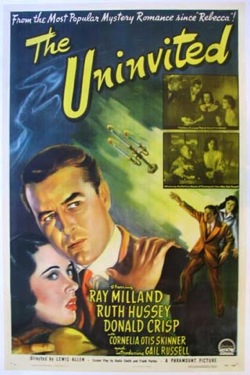
The harmony and melody of Stella By Starlight are derived from the soundtrack of the movie The Uninvited (1944).
The song has been recorded by numerous jazz musicians, including Charlie Parker (with strings), Frank Sinatra, Stan Getz, Chet Baker, Miles Davis, Joe Pass, Larry Coryell, Ella Fitzgerald, and many more.
Stella is a harmonically complex, but also a versatile standard because it can be played as a ballad, at medium tempos, as well as fast tempos.
This chord melody arrangement of Stella by Starlight is meant to be played in a typical jazz guitar trio (guitar, drum, and bass).
In a jazz trio without piano, there is no one to play the chords but you. Since you are also the one to play the melody, you have to combine playing chords and melody notes.
Stella By Starlight – Chord Melody Arrangement
Something to look out for in a chord melody arrangement like this is that the chords don’t get in the way of the melody.
When playing a chord melody arrangement, the melody notes are what’s important, and the chords are there to support the theme rhythmically and harmonically, but they may not overshadow the notes of the theme.
Backing Track
Listen & Play Along
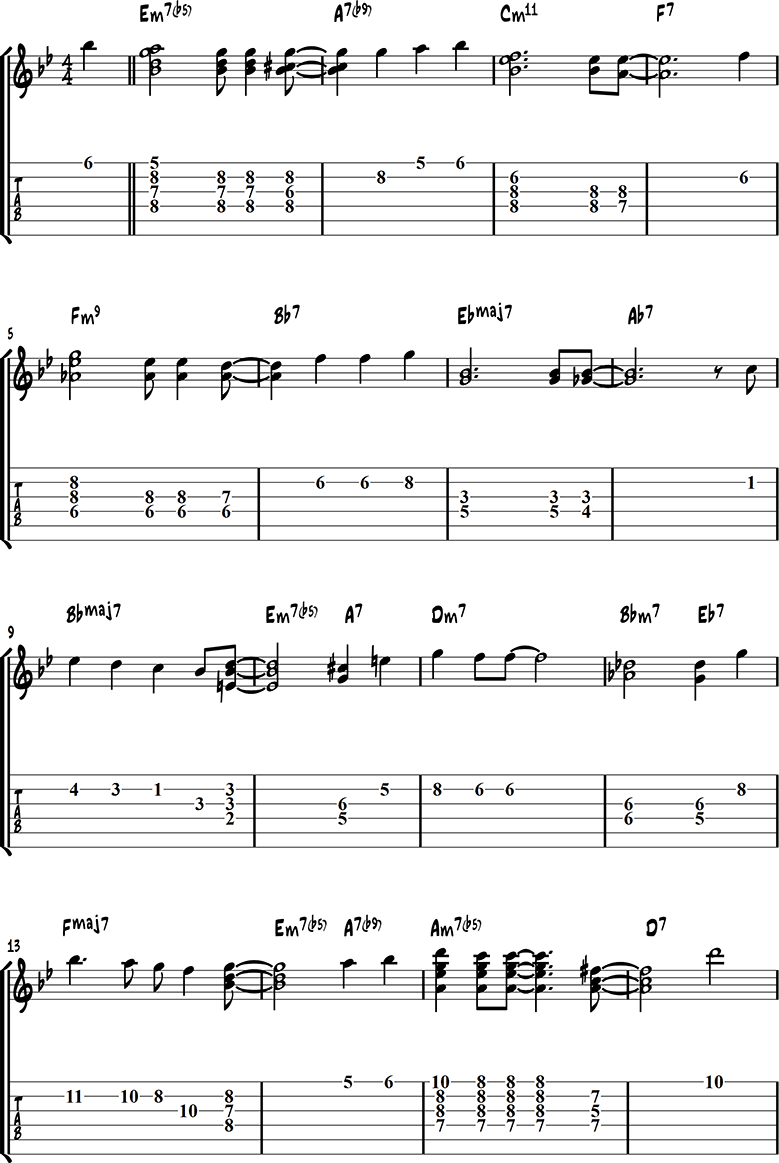
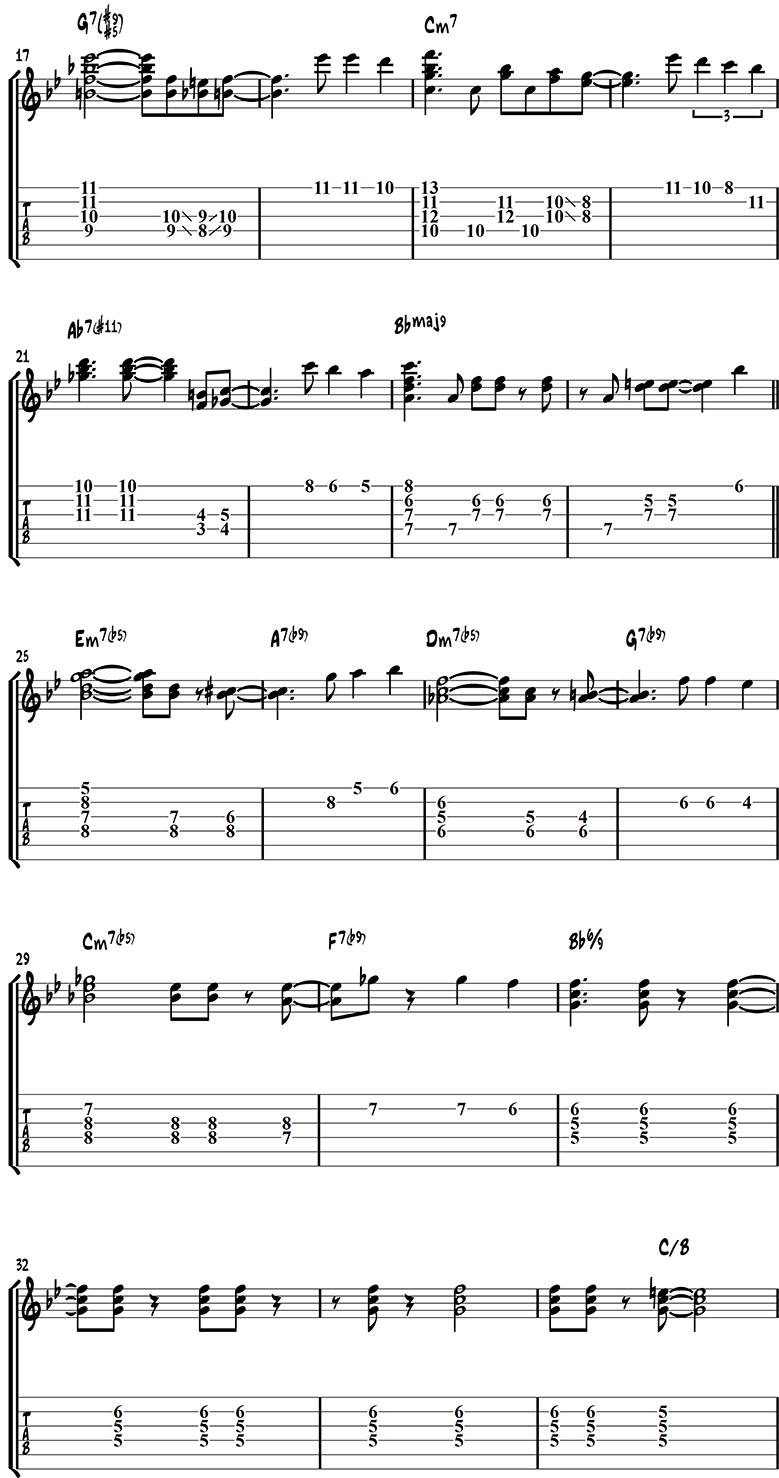
Some clarification about what I’m playing (I omitted the obvious):
- Bar 1: I really like the sound of an 11 over and m7b5 chord. You can obtain this sound in your solos by playing a Bbmaj7 or Am7 arpeggio (over Em7b5).
- Bar 9 and 13: the first note of the melody in these two bars is the 4 of the major chord, the so-called avoid note. Here it functions as a harmonic delay.
- Bar 17: the two-note in-and-out slide here is something Jaco Pastorius frequently used.
- Bar 21: the Ab7(#11) is a Lydian dominant chord.
- Bar 24: I play the #11 of Bbmaj7 here.
- Bar 31: sorry for the end guys, just following Band in a Box.
- Bar 34: the C triad over Bb is a Bb6/9(#11) chord.
Stella By Starlight – Harmonic Analysis
The harmony of Stella By Starlight is not very straight-forward because there are a lot of non-diatonic chords and ii V progressions that don’t resolve to the I.
Stella is in the key of Bb major and has 32 bars. The standard has a “vague” AABA structure, but not in the traditional sense such as in a rhythm changes. A better way to describe Stella’s form is ABCA’.
Stella By Starlight – “Modern” Chord Changes
Here is a scale analysis of Stella’s “modern” chord changes, as played by Miles Davis on his album My Funny Vallentine: Miles in Concert.
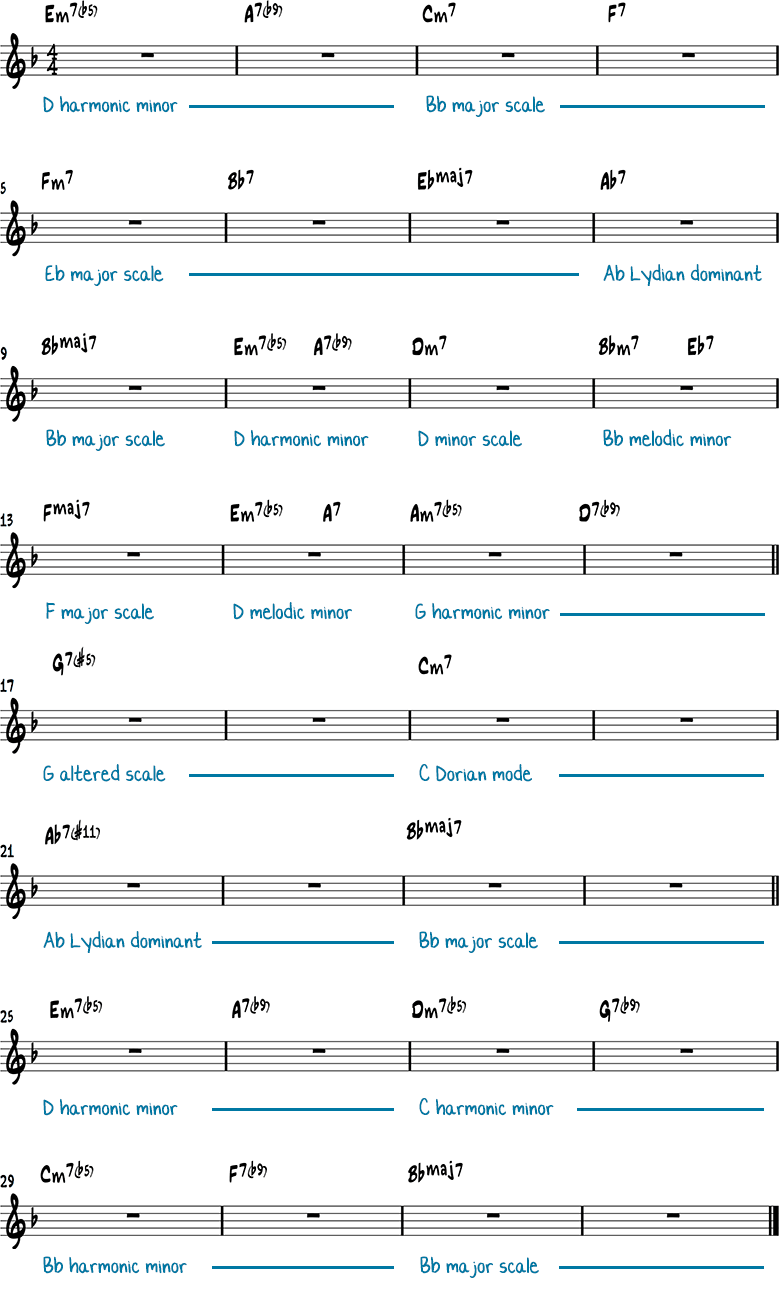
Bar 1 and 2
Stella by Starlight starts with a minor ii V progression (Em7b5-A7b9) without a resolution to the I (Dm7). There are a lot of these unresolved ii V progressions in Stella.
The scale of choice here is D harmonic minor.

Bar 3 and 4
In bar 3, we would expect a Dm7 chord, but instead, the harmony goes to a Cm7 chord that is part of another ii V that doesn’t resolve, this time in the key of Bb major.
Bar 12
This is a backdoor ii-V to Fmaj7 in the next bar.
The scale of choice here is the Bb melodic minor scale.

Stella By Starlight – Original Victor Young Chord Changes
Here are Stella’s original chord changes, composed by Victor Young for the movie The Uninvited.
The most important difference between Victor Young’s changes and the chords played by Bill Evans lies in the first 2 bars.
The Bb diminished chord in the first two bars is replaced by Em7b5-A7b9. Replacing a diminished chord with a ii V progression was standard practice in the bebop era.
Bbdim7 is a common substitute for A7b9 because they share four chord tones, as you can see below:
| Bbdim7 | Bb | Db | Fb | Abb | |
|---|---|---|---|---|---|
| A7b9 | A | Bb | C# | E | G |
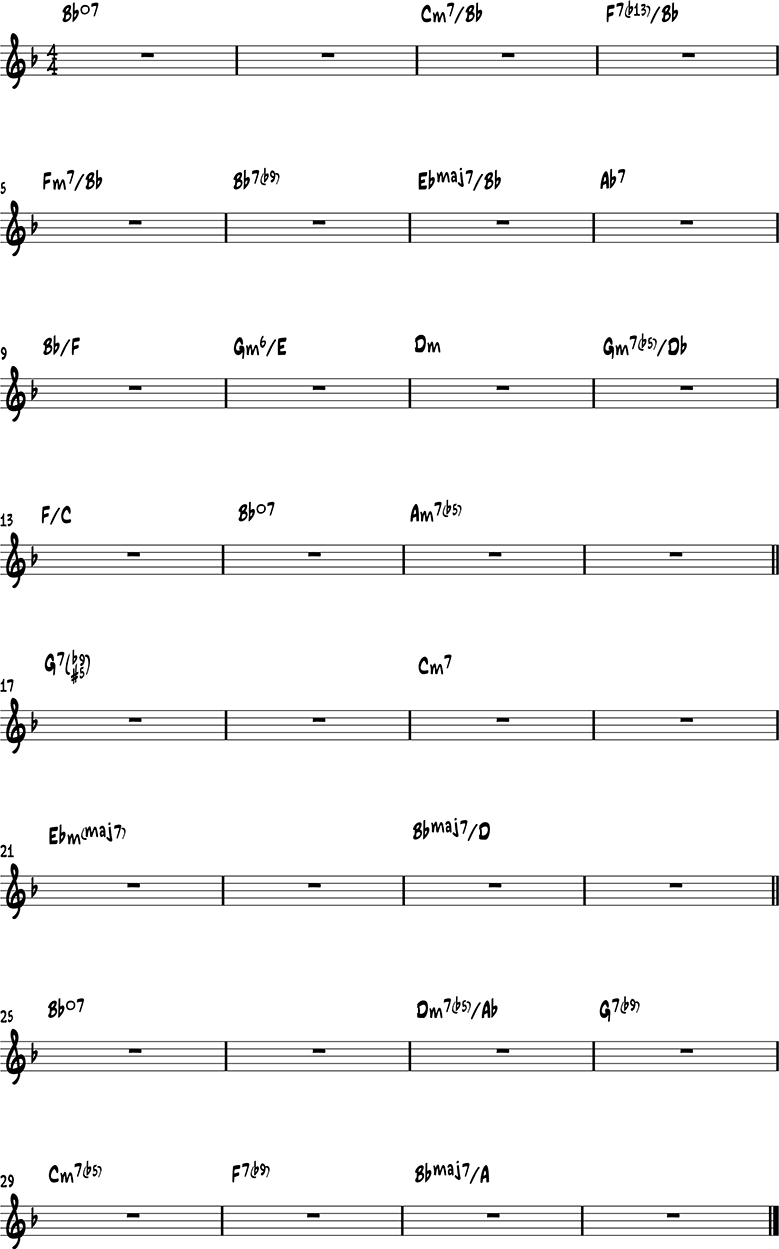
Stella By Starlight – Voice Leading
As you can see in the scale analysis above, Stella by Starlight is not simple to improvise over.
Changing scales every bar is not easy and doesn’t sound very musical, so it’s better to rely on arpeggios or focus on voice leading.
A good voice leading makes your improvised solos sound natural and gives you a framework to base your solo on.
Here is a voice leading example to get you started. The numbers in blue indicate which chord tones (or tensions) are played.
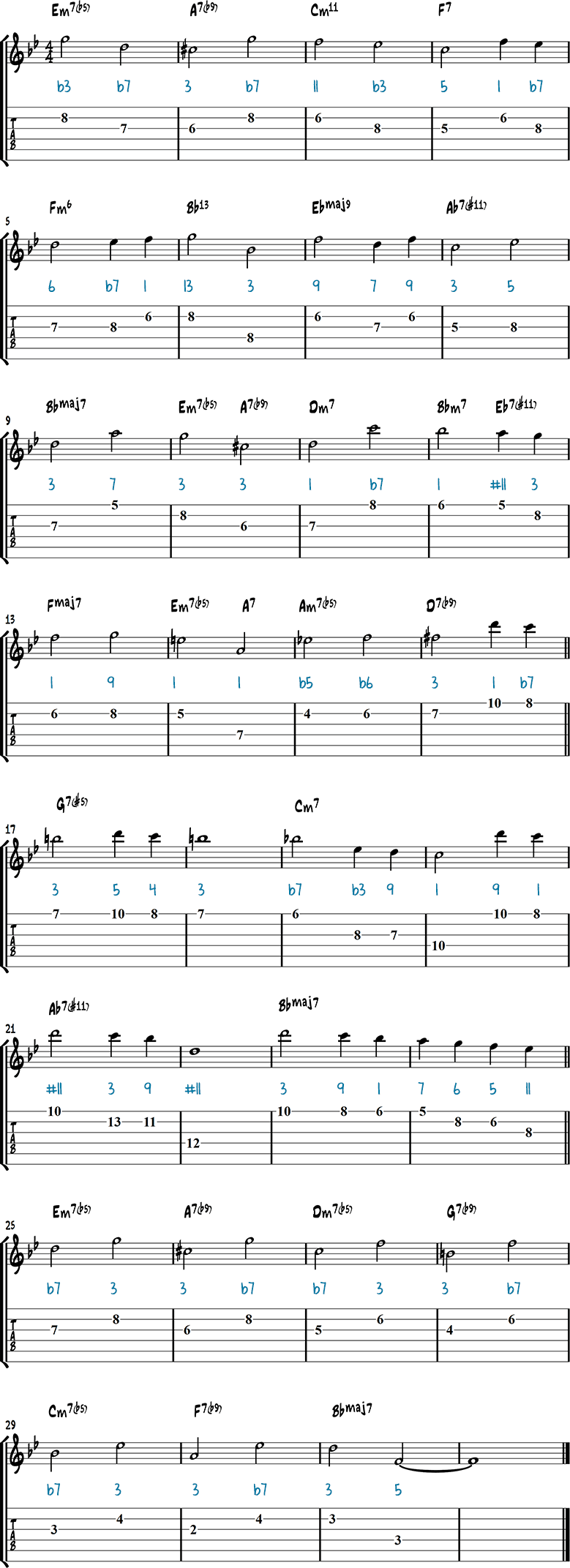


Boa tarde!
Simplesmente, maravilhoso. Parabéns!
Thanks for the very nice explanation of this song!
Mark Levine suggests for the very first bar instead of the Em7b5 an A7susb9 chord, spelled like Bb-D-E-A, like 4th string VIII, 3rd string VII, 2nd and 1st string V.
Quite a nice voicing!
Love this worksheet,
Do you have it in pdf for ease of reading
BRAVO
Hi Johanna, use the “Print & PDF” button, just above the comments section. Cheers!
Thanks a lot for all this work, very interesting.
Ivan from Paris
amazing analysis, thanks a lot… from paris
GOOD !!!!!
once again brilliant lessons ..2 favs.. another you and stella…. thanks from England,
Nice lesson
Short answer, because we’re resolving to D minor. Hence, the D melodic or harmonic minor scales contain all the notes we need to spell out the ii V and the i chord.
Specifically, and to your point, G melodic minor would work over the ii chord, but only for that chord. You get the natural 2. If I was showing someone new to jazz what to play over a ii V, I would just have them play with the harmonic minor scale of the resolution chord. The real priority is to tag the chord tones and spell out the changes in your melody.
On a more esoteric note, as improvisers, we tend to start omitting the ii chord altogether, that is unless there are multiple bars of one chord, or it’s not part of a cadence altogether. But staying with the idea of omitting the ii chord, we usually lump the ii with its V and consider them one thing. The symbols are just symbols, and if there is a bass player holding down a root, or possibly a third, you can theoretically play anything over that bass note. Maybe a piano player plays some rhythmic stabs, but nothing long enough to saturate the harmony or fix it on any one sound. Your ii chord can be Phrygian or Aeolian, it really depends on how the bad is playing.
Ultimately, half-diminished chords are usually just a rhythmic placeholder. It’s there to prepare the dominant chord. You as a soloist can jump the gun and start playing on the dominant chord a couple of beats before it even comes up. The ii chord is very open to interpretation, minor cadences are usually more flexible.
Why is D melodic minor the right scale for the E-7b5 A7b9? Wouldn’t it be G melodic minor ( sixth mode would be the half diminished scale). Do not understand. There seem many ways to deal with the G+7 to Cm7 but the half diminished chords would want a half diminished scale, right?
I think that d melodic minor is being used to bring out colors of the A7b9 and not so much the Em7b9.
The Bb melodic minor scale would be more appropriate for the E-7 /A7 movement. (Offers a nice 1/2 step, chromatic movement in the progression )